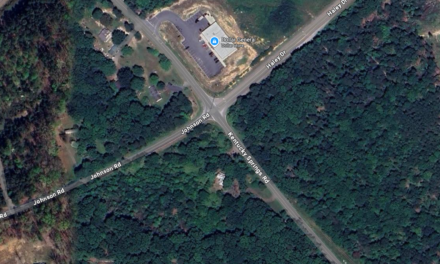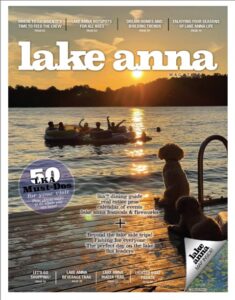
Ever since word reached Lake Anna that the Virginia General Assembly had earmarked $1 million for Harmful Algae Bloom (HAB) mitigation at Lake Anna, members of the Lake Anna Advisory Committee (LAAC) have been working on how to best spend this money. As of late February, LAAC has published a request for proposal (RFP) to remove the excess phosphorus from the lake feeding the algae blooms, received proposals from two offerors, and is working with both on a plan to treat two out of the three upper tributaries of Lake Anna while leaving one as a control.
“LAAC will execute the state funding and manage a new program, called the Lake Anna Cyanobacteria Mitigation and Remediation Program (LACMRP), that will initiate actions in the spring of 2024 to reduce excess phosphorous levels in the upper lake. This is a major step forward and one that will set conditions for expanded phosphorus reduction efforts in the years to come,” noted Louisa County LAAC Citizen Representative and Chair of the Environmental Subcommittee Harry Looney in a recent email.
Louisa County Cuckoo District Supervisor Christopher McCotter appointed Looney to LAAC in early February. Looney and McCotter serve on a work group that oversaw the RFP, review of proposals and negotiations with offerors along with Bill Deeds, Kim Wolfe and Jeff Palmer. Louisa County Administrator Christian Goodwin and Louisa County Finance Director Wanda Colvin were also an important part of the effort as Louisa County is acting as the agent for the the state funding (with agreement of LAAC member counties Orange and Spotsylvania) that originated from the Department of Conservation and Recreation.
The funding is being directed toward the implementation of several of the alternative chemical and biological best management practices that have demonstrated to be effective phosphorus reduction treatments.
The two offerors are EutroPHIX/Solitude Lake Management and Clean Streams, Rivers and Lakes (CSRL). Each proposed their own way of removing excess phosphorus from the lake, both legacy (already in the lake) and watershed inflow.
Both companies proposed introducing inert materials to the lake that bind to phosphorus therefore not permitting it to suspend in the water column and serve as food for algae. EutroPHIX/Solitude Lake Management are nationwide water quality solutions companies that have teamed up for the proposal. EutroPHIX utilizes its own proprietary material: EutroSORB G, a type of lanthanum modified bentonite clay, to remove phosphorus from aquatic systems. CSRL proposes the use of Wollastonite (calcium silicate) also a mined material, but consisting of 44.1% calcium oxide, 51.3% silicon dioxide, 1.1% aluminum oxide, 1.7% magnesium oxide and traces of other materials – all EPA approved, however Dominion Energy has not yet weighed in on the material’s potential effect on their equipment.
EutroPHIX/Solitude would also install injection systems in the tributary they were assigned to treat incoming phosphorus from the watershed using their proprietary EutroSORB SW liquid. CSRL proposes to use beneficial bacteria reactors that would encourage good bacteria to grow on them and starve out harmful algae blooms.
The RFP was for a five-year program. The EutroPHIX/Solitude proposal was in excess of $13 million over the term. CSRL’s proposal came in under $1 million.
Given the wide variance in cost between the two offers and the acceptable level of technical and management risk, LAAC is considering a dual award approach to use the base year as a concept development phase. If this approach is approved, one offeror will be assigned to the North Anna Branch and the other to Terry’s Run. Pamunkey Branch will not be in the scope for the base year, and it will be used as a control area.
“We are also hesitant to start anything in the Pamunkey Branch due to the continuation of the Department of Environmental Quality/USGS data collection efforts as part of a two-year state funded study,” Looney noted in a recent communication.
Virginia Department of Wildlife Resources District Biologist John Odenkirk was also consulted by the LAAC work group. Odenkirk has been monitoring and studying Lake Anna for years. He was the one that suggested a control area. He also noted that despite high levels of phosphorus and the term eutrophic used to describe the upper portion of the lake, the fishery is scientifically considered excellent. He warned that removing phosphorus will have an effect.
“DEQ classifications per “hyper eutrophication, etc. are not overly meaningful in terms of fisheries implications. Many public fishing lakes we fertilize are considered hypereutrophic by DEQ and are quite healthy.
“The fishery at Anna is booming now thanks to a productive system with good habitat. A reduction in that productivity (phosphorus is the essential limiting nutrient in any aquatic system) WILL result in reduced productivity up the food chain (e.g., reduced phytoplankton=reduced zooplankton=less fish in biomass).”
McCotter noted LAAC expects to have answers from both offerors by the end of March on how the LACMRP will proceed in 2024.
“HABs continue to cause issues for Lake Anna which is a critically important asset to our community. We are grateful for this funding and the opportunity to put it to responsible use for mitigating algae and hope the effort might serve as a model for other areas grappling with similar situations,” County Administrator Christian Goodwin told Lake Anna Life & Times.
























